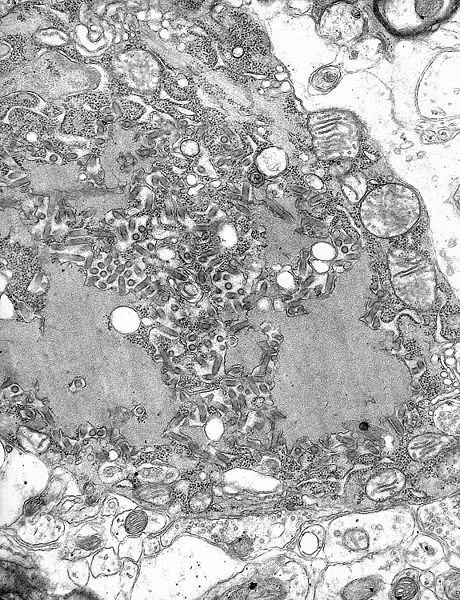Rabies history and symptoms: Difference between revisions
Jump to navigation
Jump to search
No edit summary |
No edit summary |
||
| Line 1: | Line 1: | ||
__NOTOC__ | |||
{{Rabies}} | |||
{{CMG}} | |||
== History and Symptoms == | == History and Symptoms == | ||
[[Image:Rabies Virus EM PHIL 1876.JPG|thumb|250px|Micrograph with numerous rabies [[virion]]s (small dark-grey rod-like particles) and [[Negri bodies]], larger [[pathognomonic]] cellular inclusions of rabies infection]] | [[Image:Rabies Virus EM PHIL 1876.JPG|thumb|250px|Micrograph with numerous rabies [[virion]]s (small dark-grey rod-like particles) and [[Negri bodies]], larger [[pathognomonic]] cellular inclusions of rabies infection]] | ||
Revision as of 21:02, 17 December 2012
|
Rabies Microchapters |
|
Diagnosis |
|---|
|
Treatment |
|
Case Studies |
|
Rabies history and symptoms On the Web |
|
American Roentgen Ray Society Images of Rabies history and symptoms |
|
Risk calculators and risk factors for Rabies history and symptoms |
Editor-In-Chief: C. Michael Gibson, M.S., M.D. [1]
History and Symptoms

- The period between infection and the first flu-like symptoms is normally two to twelve weeks, but can be as long as two years.
- The first symptoms of rabies may be nonspecific flu-like signs — malaise, fever, or headache, which may last for days.
- There may be discomfort or paresthesia at the site of exposure (bite), progressing within days to symptoms of cerebral dysfunction, anxiety, confusion, agitation, progressing to delirium, abnormal behavior, hallucinations, and insomnia.
- The acute period of disease typically ends after 2 to 10 days (6).
- Once clinical signs of rabies appear, the disease is nearly always fatal, and treatment is typically supportive. Disease prevention is entirely prophylactic and includes both passive antibody (immune globulin) and vaccine.
- Non-lethal exceptions are extremely rare.
- To date only six documented cases of human survival from clinical rabies have been reported and each included a history of either pre- or postexposure prophylaxis.
- The few humans who are known to have survived the disease were all left with severe brain damage, with the recent exception of Jeanna Giese (see below).